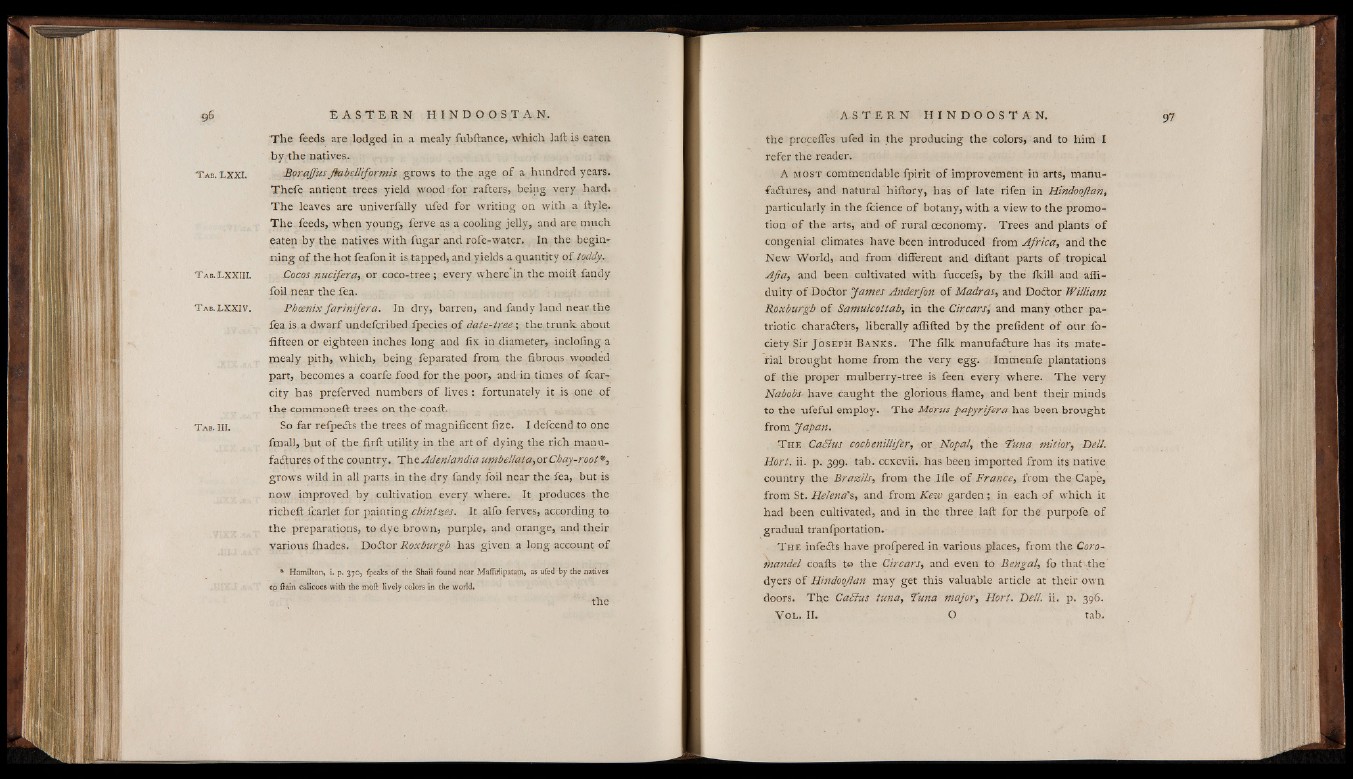
g6
T ab, LXXI.
T ab-LX X III.
T a b. L X X I V.
T a b . III.
T he feeds are lodged in a mealy fubftance, which laft is eaten
by the natives.
Boraffus Jtabelliformis grows to the age of a hundred years.
Thefe antient trees yield wood for rafters, being very hard.
The leaves are univerfally ufed for writing on with a Ryle.
The. feeds, when young, ferve as a cooling jelly, and are much
eaten by the natives with fugar and rofe-water. In the beginning
o f the hot feafon it is tapped, and yields a quantity o f toddy.
Cocos nucífera, or coco-tree ; every where in the moift fandy
foil near the fea.
Phoenix farinifera. In dry, barren, and fandy land near the
iba is a dwarf undefcribed fpecies of date-tree; the trunk about
fifteen or eighteen inches long and fix in diameter, inclofing a
mealy pith, which, being feparated from the fibrous wooded
part, becomes a coarfe food for the poor, and in times of fcar-
city has preferved numbers of lives : fortunately it is one of
the commoneft trees on the coaft.
So far refpeCts the trees of magnificent fize. I defcend to one
fmall, but of the firft utility in the art of dying the rich manufactures
o f the country. T h zAdenlandia umbellata,oxChay-root*,
grows wild in all parts in the dry fandy foil near the fea, but is
now improved by cultivation every where. It produces the
richeit ibarlet for painting chintzes. It alfo ferves, according to
the preparations, to dye brown, purple, and orange, and their
various ihades. DoCtor Roxburgh has given a long account o f
* Hamilton, i. p. 370, fpeaks of the Shaii found near Maflidipatam, as ufed by the natives
to ilain calicoes with the moil lively colors in the world.
the
the proceffes ufed in the producing the colors, and to him I
refer the reader.
A m o s t commendable fpirit of improvement in arts, manufactures,
and natural hiftory, has of late rifen in Hindoojlan,
particularly in the fcience of botany, with a view to the promotion
of the arts, and of rural ceconomy. Trees and plants o f
congenial climates have been introduced from Africa, and the
New World, and from different and diftant parts of tropical
AJia, and been cultivated with fuccefs, by the ikill and afii-
duity of DoCtor James Anderfon o f Madras, and DoCtor William
Roxburgh of Samulcottah, in the Circars, and many other patriotic
characters, liberally afiifted by the prefident o f our fo-
ciety Sir J o s e p h B a n k s . The filk manufacture has its material
brought home from the very egg. Immenfe plantations
o f the proper mulberry-tree is feen every where. The very
Nabobs- have caught the gldrious flame, and bent their minds
to the ufeful employ. The Morus papyri/era has been brought
from Japan.
T he CaBus cochenillifer, or Nopal, the Tuna mitior, Dell.
Hort. ii. p. .399. tab. ccxcvii. has been imported from its native
country the Brazils, from the ,Iile o f France, from the Cape,
from St. Helena's, and from Kew garden; in each o f which it
had been cultivated, and in the three laft for the purpofe o f
gradual tranfportation.
T he infeCts have profpered in various places, from the Coromandel
coafts to the Circars, and even to Bengal, fo that.the
dyers of Hindoojlan may get this valuable article at their own
doors. The CaBus tuna, Tuna major, Hort. Dell. ii. p. 396.
V o l . II. O tab.